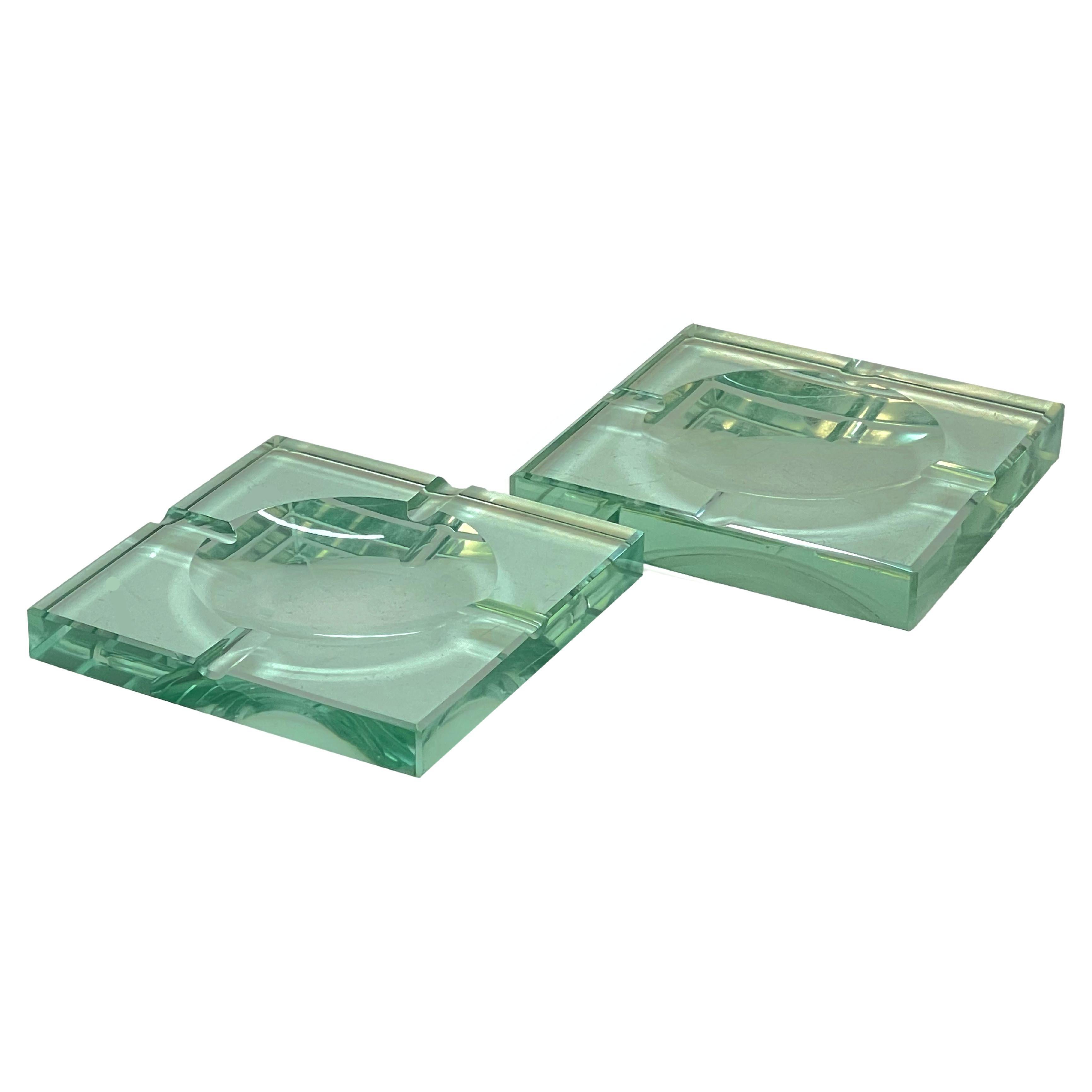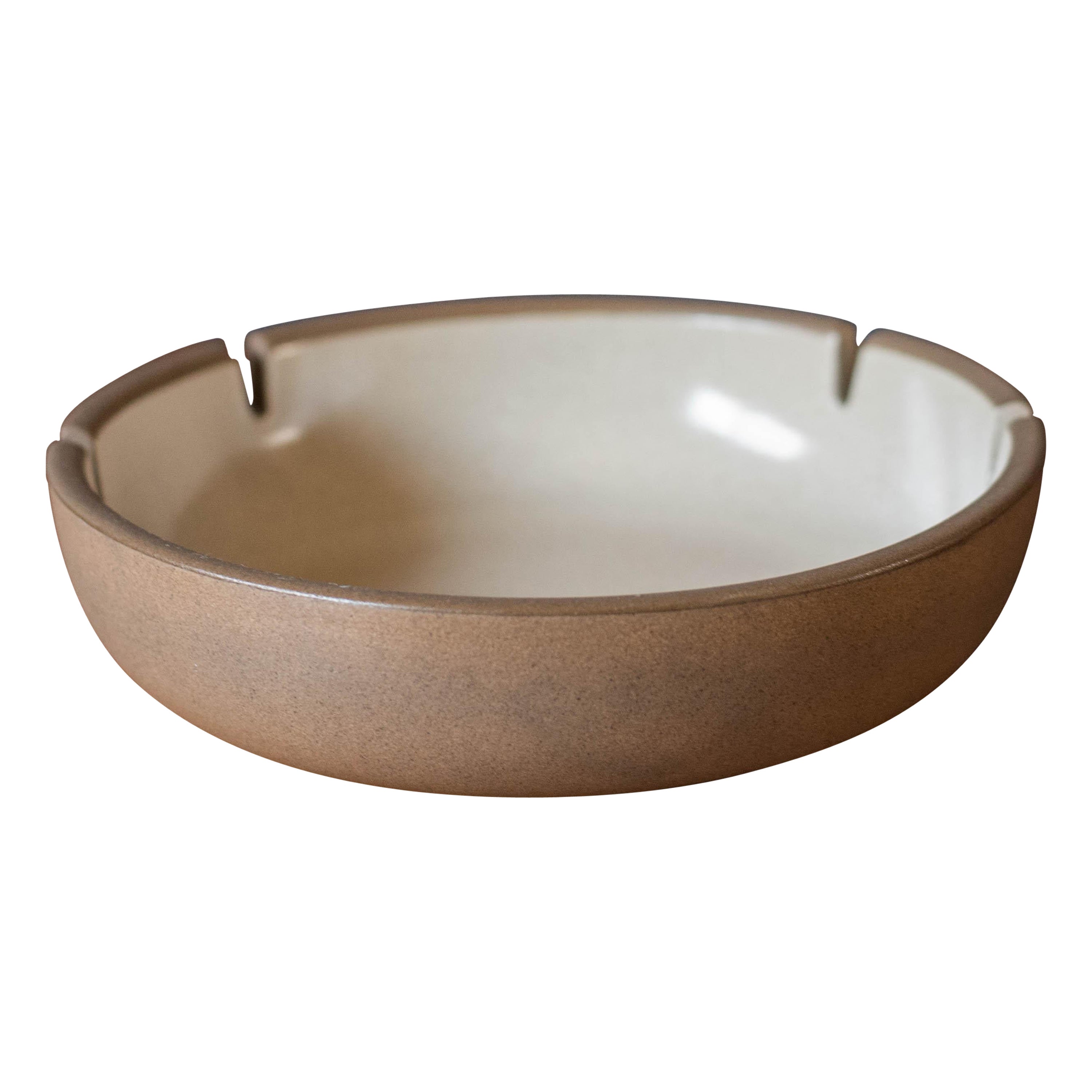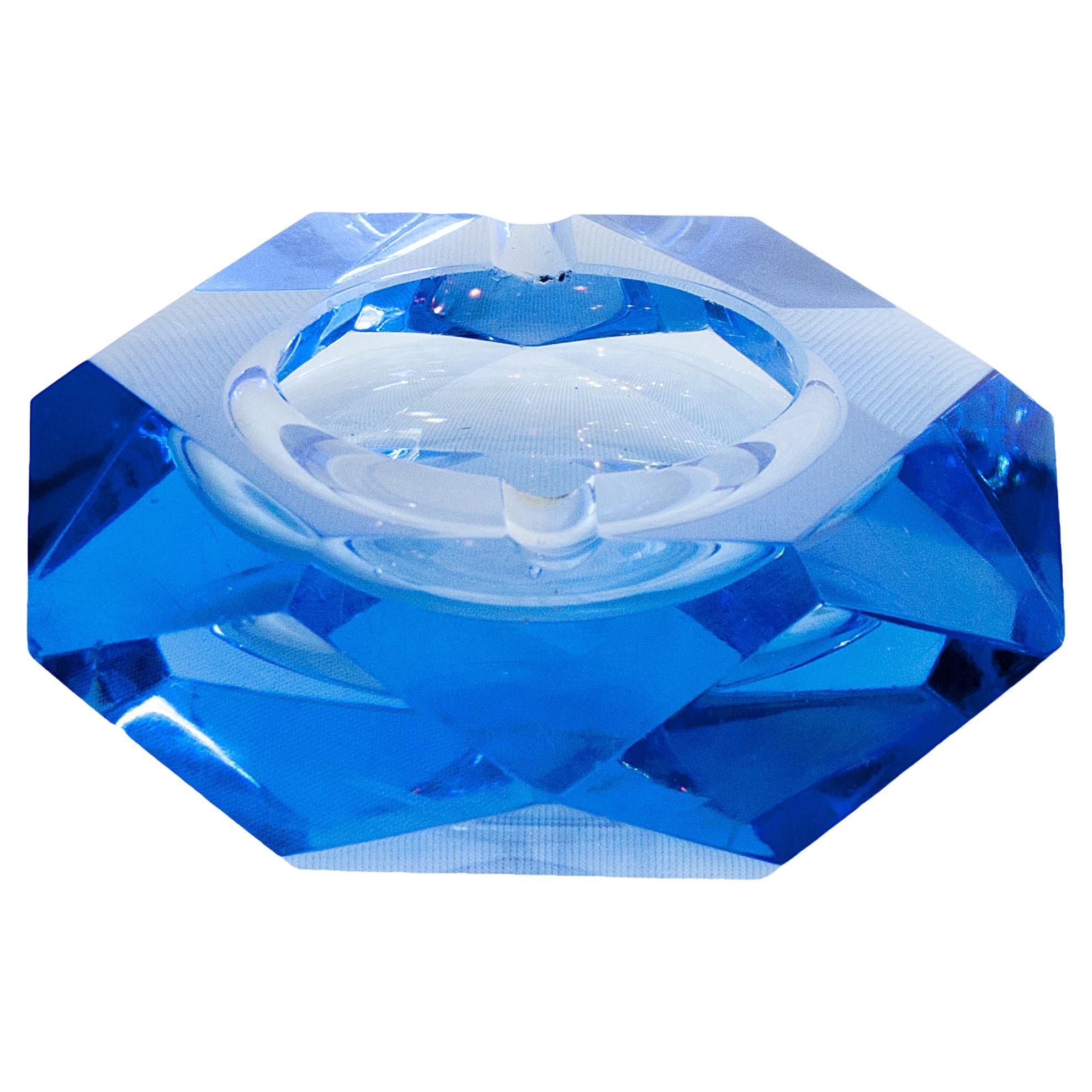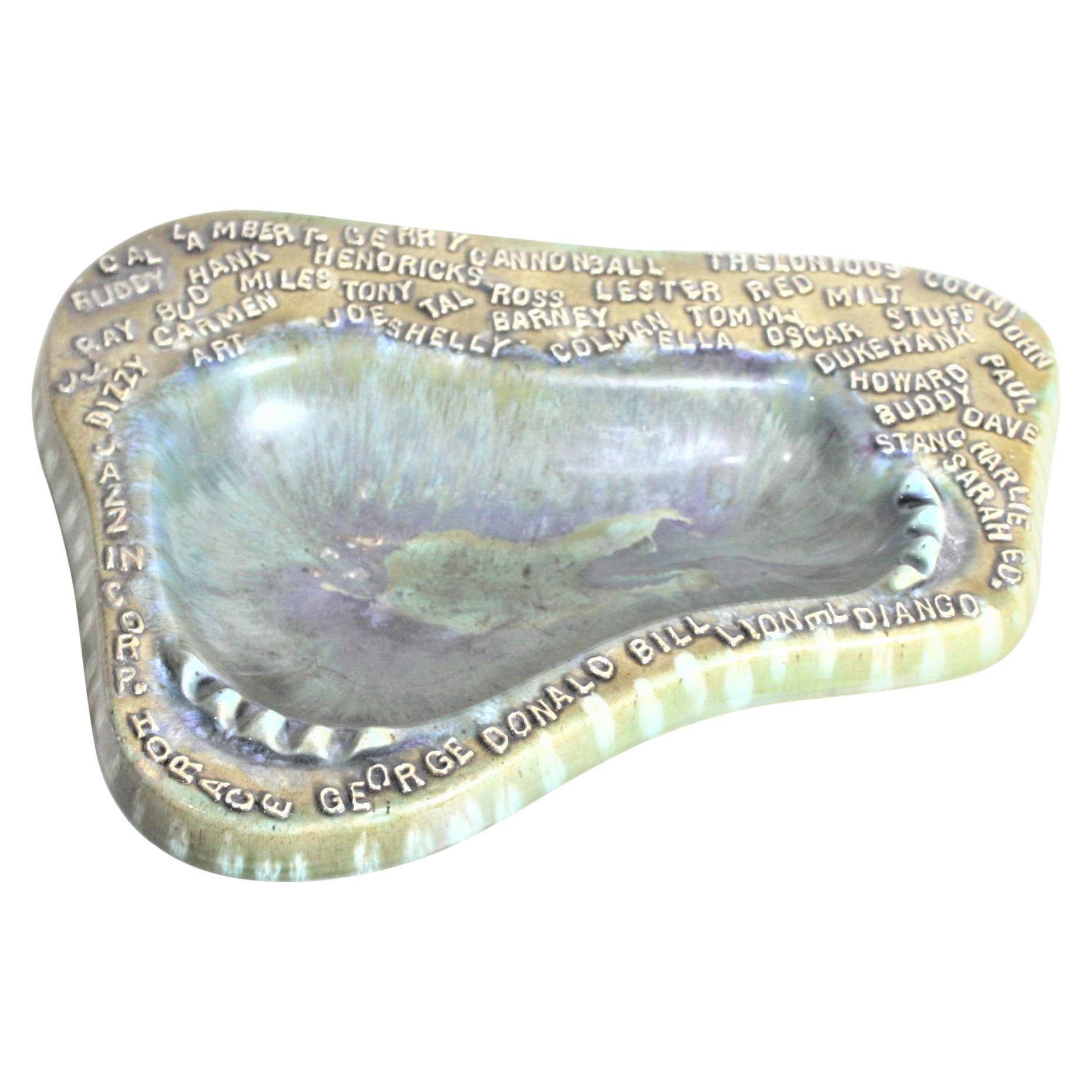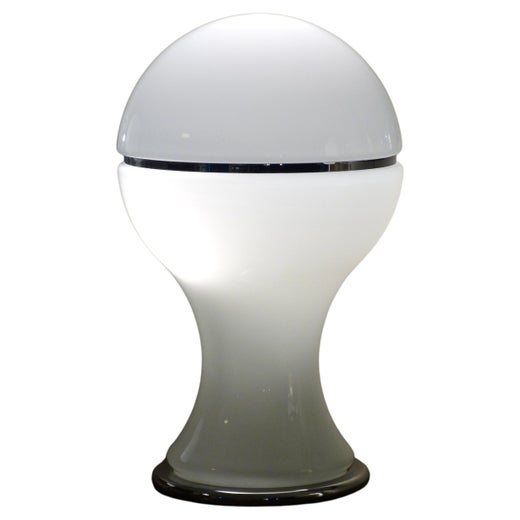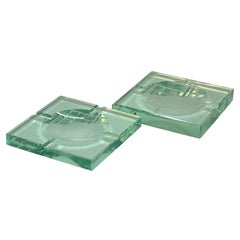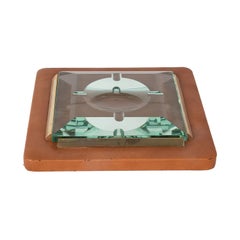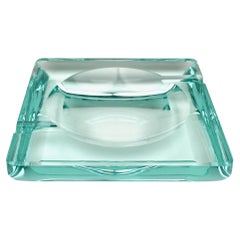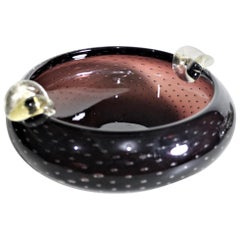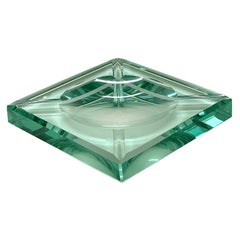
Mid-Century Modern Fontana Arte Green Crystal Glass Squared Italian Ashtray
View Similar Items
Mid-Century Modern Fontana Arte Green Crystal Glass Squared Italian Ashtray
About the Item
- Creator:Fontana Arte (Manufacturer)
- Dimensions:Height: 0.79 in (2 cm)Width: 5.12 in (13 cm)Depth: 5.12 in (13 cm)
- Style:Mid-Century Modern (Of the Period)
- Materials and Techniques:
- Place of Origin:
- Period:
- Date of Manufacture:1960s
- Condition:
- Seller Location:Roma, IT
- Reference Number:1stDibs: LU3067325857512
Fontana Arte
Best known for its elegant and innovative vintage lighting fixtures, the Milan-based firm Fontana Arte pioneered one of the key features of 20th-century and contemporary Italian design: the union of artistry and industry wrought by partnerships between creative talents — chiefly architects — and entrepreneurial businesses. Fontana Arte is further distinguished by having had as artistic director, in succession, four of Italy’s most inventive modernist designers: Gio Ponti, Pietro Chiesa, French transplant Max Ingrand and Gae Aulenti.
The bread and butter of the glassmaking company that Luigi Fontana founded in 1881 was plate-glass panels for the construction industry. In 1930, Fontana met Ponti — then the artistic director of the Richard Ginori ceramics workshop and the editor of the influential magazine Domus — at a biannual design exhibition that became the precursor to today’s Milan Design Triennale, and the two hatched an idea for a furniture and housewares firm. Fontana Arte was incorporated in 1932 with Ponti as its chief of design. He contributed several lamps that remain among the company’s signature works, including the orb-atop-cone Bilia table lamp and the 0024 pendant — a stratified hanging sphere.
The following year, Fontana Arte partnered with the influential Milan studio glassmaker and retailer Pietro Chiesa, who took over as artistic director. Chiesa’s designs for lighting — as well as for tables and items including vases and ashtrays — express an appreciation for fluidity and simplicity of line, as seen in works such as his flute-shaped Luminator floor lamp and the 1932 Fontana table — an arched sheet of glass that is held in the permanent collection of the Museum of Modern Art.
Six years after Chiesa’s 1948 death, the École des Beaux Arts–trained Max Ingrand took over as head of design at Fontana Arte. Ingrand brought a similarly expressive formal sensibility to wares such as lamps and mirrors, but he also had a masterful eye for the manipulation of glass surfaces — whether they be cut, frosted, acid-etched or sand-blasted. His classic design is the Fontana table lamp of 1954, which has a truncated cone shade and curved body, both of which are made of pure, chic white-frosted glass.
Following Ingrand, the often-audacious Italian architect Gae Aulenti served as the company’s artistic director from 1979 to 1996, and while she generally insisted that furnishings take second place aesthetically to architecture, she made an exception for Fontana Arte pieces such as the Tavolo con Ruote series of glass coffee and dining tables on wheels, bold lighting pieces such as the Parola series and the Giova, a combination flower vase and table lamp. As a key incubator of modern design under Aulenti’s tenure, Fontana Arte remained true to its long-held commitment — creating objects that have never been less than daring.
Find vintage Fontana Arte lighting fixtures such as pendants, table lamps and more on 1stDibs.
- Pair of Fontana Arte Midcentury Green Crystal Glass Squared Italian AshtraysBy Fontana ArteLocated in Roma, ITTwo Incredible Mid-Century Modern square green glass ashtrays. These wonderful pieces were produced by Fontana Arte in Italy during the 1960s. ...Category
Mid-20th Century Italian Mid-Century Modern Ashtrays
MaterialsCrystal
- Fontana Arte 1970s, Ashtray in Leather, Brass and Faceted Glass, Italy Art GlassBy Fontana ArteLocated in Roma, ITFontana Arte 1970s. Ashtray in leather, brass and faceted glass.Category
Mid-20th Century Italian Mid-Century Modern Ashtrays
MaterialsGlass
- Midcentury Pietro Chiesa Carved Crystal Glass Italian Ashtray for Fontana ArteBy Fontana Arte, Pietro ChiesaLocated in Roma, ITAmazing midcentury carved crystal glass ashtray. This wonderful item was designed by Pietro Chiesa for Fontana Arte in Italy during 1960s. This piece is unique as it has two carved sides and two straight ones and tone of the crystal, that is a very elegant water marine. A perfect bowl to complete a midcentury-style living room or entrance. Measures (cms): width - 20 depth - 20 height - 2 Pietro Chiesa (1892-1948) was an Italian designer who specialised in modernist and Art Deco designs. Chiesa was one of the founding members of FontanaArte which was established in 1932, and as its artistic director, he designed hundreds of items ranging from furniture to objets d’art. A member of the Swiss Ticino family of artists, Chiesa is best known for his glass furnishing pieces, such as the Fontana table. Fontana Arte (established in 1933) was founded by Luigi Fontana, Gio Ponti, and Pietro Chiesa as a premier producer and marketer of furniture, lighting, and furnishing accessories, and distignuished itself applying the highest standards of glass craftsmanship and techniques. Throughout Fontana Arte’s history, its lamps and furniture have been highly sought after due to their superior glass craftsmanship and innovative design. Saint-Gobain Invests in Luigi Fontanta e Compagni The origins of Fontana Arte go back to 1881, when Luigi Fontana established Luigi Fontana e Compagni to produce and market sheet glass for the construction industry. Luigi’s success as an entrepreneur in the growing Italian construction sector attracted the attention of the French glass-making company Saint-Gobain, which, in 1910, took a majority stake in the ownership of Luigi Fontana e Compagni transforming it into a “Società Anonima” still under the direction of Luigi Fontana. By the mid-1920s, Fontana e Compagni’s capabilities included the creation of artistic stained glass that was mostly used in functional and decorative settings of churches and cathedrals. Gio Ponti Becomes Fontana e Compagni’s Artistic Director In just a few years, the production of such artistic stained-glass products had become of such importance that a different division within the Fontana e Compagni was created to further its development. In 1930, Luigi Fontana met the successful young Milanese architect Gio Ponti, who was then the art director of Richard-Ginori pottery company, and they formed a partnership, under the name of Luigi Fontana SA, for the production of light fixtures, furniture, and furnishing objects. During this initial period, Gio Ponti designed from Fontana Arte the now-iconic 0024 Pendant light (1931) and the Bilia Table Lamp (1931). Pietro Chiesa, Gio Ponti, and Luigi Fontana Found Fontana Arte In 1932, Gio Ponti approached Pietro Chiesa to join him and Luigi Fontana and to become Luigi Fontana SA’s artistic director. In 1933, Pietro Chiesa merged his studio, the Bottega di Pietro Chiesa, with Fontana SA, and together Luigi Fontana, Gio Ponti, and Chiesa founded Fontana Arte. During Chiesa’s tenure as artistic director, Fontana Arte’s production became rich and varied. It included furniture, tables, mirrors, sculptures, and stained glass, but it was certainly in the lighting sector where Fontana Arte excelled by creating lamps and lights with the highest standards in glass craftsmanship and modern designs. From this period came the Luminator floor lamp, the Cartoccio glass vase, and the Fontana Arte table made out of a single band of bent clear glass, (all designed by Pietro Chiesa, in 1932); and the Naska lamp...Category
Mid-20th Century Italian Mid-Century Modern Decorative Bowls
MaterialsCrystal
- Mid-Century Modern Gilded Brass and Black Iron Italian Ashtray, 1950sBy Mathieu MatégotLocated in Roma, ITAmazing Mid-Century Modern gilded brass and black iron ashtray. This fantastic piece was designed in Italy during the 1950s. This astonishing piece is going to be loved by the mix...Category
Early 20th Century Italian Mid-Century Modern Tobacco Accessories
MaterialsIron, Brass
- Midcentury Squared White Travertine Marble Italian Ashtray After Mannelli, 1970sBy Fratelli MannelliLocated in Roma, ITElegant midcentury squared white travertine marble ashtray. This fantastic piece was designed in Italy during the 1970s after Fratelli Mannelli. This wonderful item took inspirati...Category
Late 20th Century Italian Mid-Century Modern Tobacco Accessories
MaterialsTravertine, Marble
- Midcentury Round Ashtray White Travertine Marble and Steel, Mannelli Italy 1970sBy Fratelli MannelliLocated in Roma, ITElegant midcentury rounded white travertine marble ashtray or bowl. Fratelli Mannelli probably designed this fantastic piece in Italy during the 1970s. This wonderful item is made...Category
Late 20th Century Italian Mid-Century Modern Tobacco Accessories
MaterialsTravertine, Marble, Metal, Steel, Chrome
- Squared Ashtray Green Crystal Glass by Fontana Arte Italy 1960sBy Fontana ArteLocated in Rome, ITMid-Century Modern square green glass ashtray. This wonderful piece was produced by Fontana Arte in Italy during the 1960s. It is composed of ...Category
Vintage 1960s Italian Mid-Century Modern Ashtrays
MaterialsCrystal
- Mid-Century Modern Murano Seguso Styled Amethyst Art Glass Cigar AshtrayBy Angelo SegusoLocated in Hamilton, OntarioThis Mid-Century Modern unique art glass cigar ashtray is unsigned, but presumed to have been made in Murano Italy in circa 1965 in the style of Angelo Seguso. The body of the ashtra...Category
Mid-20th Century Italian Mid-Century Modern Tobacco Accessories
MaterialsArt Glass
- Vintage Edith Heath Mid-Century Modern Large AshtrayBy Heath Ceramics, Edith HeathLocated in North Hollywood, CAVintage Mid-Century Modern ceramic ashtray by Edith Heath Mid-Century Modern large vintage pottery ashtray by Edith Heath for Heath Ceramics....Category
Mid-20th Century American Organic Modern Ashtrays
MaterialsPottery, Ironstone, Stoneware, Ceramic
- Mid Century Modern California Studio Pottery Ashtray by Heath CeramicsBy Heath Ceramics, Edith HeathLocated in San Jose, CAVintage stoneware studio pottery ashtray designed by Edith and Brian Heath for Heath Ceramics of Sausalito, California. Features a two-tone contrasting ...Category
Vintage 1960s American Mid-Century Modern Tobacco Accessories
MaterialsCeramic, Pottery, Stoneware
- Ashtray 1950 CrystalLocated in Ciudad Autónoma Buenos Aires, CCrystal We have specialized in the sale of Art Deco and Art Nouveau and Vintage styles since 1982. If you have any questions we are at your disposal. Pushing the button that reads ...Category
Vintage 1950s Italian Space Age Ashtrays
MaterialsCrystal
$2,450 - Ashtray Crystal, 1950Located in Ciudad Autónoma Buenos Aires, CCrystal We have specialized in the sale of Art Deco and Art Nouveau and Vintage styles since 1982. Why are there so many antiques in Argentina? In the 1880 – 1940 there was a grate wave of immigration encouraged by the periods of war that were taking place. 1st World War took place between 1914 and 1918 2nd World War took place between 1939 and 1945 The immigrants options were New York or Buenos Aires. Tickets were cheap and in Buenos Aires they were welcomed with open arms, as it was a country where everything was still to be done. Argentina was the country of new opportunities, labour was needed and religious freedom was assured, in many cases the of the family travel first until they were settled and then the rest of the family members join them. In the immigrant museum “Ellis Island Immigrant Building” in New York you can se the promotional posters of the boats that would take them to a new life. Between the years 1895 and 1896, Argentina had the highest DGP (gross domestic product) per capita in the world according to the Maddison Historical Statistics index, this situation arose due to the large amount of food being exported to European countries, which were at war. The Argentinean ships left the port of Buenos Aires with food, but they returned with furniture, clothes and construction elements, (it´s common to see this the old buildings of the historic neighbourhood of San Telmo, the beams with the inscription “Made in England)”, as well as many markets that were built in Buenos Aires, such us the San Telmo Market, whose structure was brought by ship and afterwards assembled in 900 Defensa Street. With the great influence of European immigrants living in the country, the children of the upper classes travelled to study in France, resulting in the inauguration of “La Maison Argentinienne”, on 27th of June 1928, in the international city of Paris, which hosted many Argentinians that were studying in Frace. It´s the fourth house to be built after France, Canada and Belgium, being the first Spanish-speaking one. Still in place today (17 Bd Jourdan, 75014, Paris, France). Many of the children of these wealthy families who attended international art exhibitions, museums and art courses abroad, took a keen interest in the European style. This is why Buenos Aires was at the time referred as “The Paris of South America”. Between the years 1890 and 1920 more than a hundred Palaces were built on Alvear Avenue the most exclusive avenue in Buenos Aires. Today some of these palaces have been transformed into museums, hotels and embassies. In the year 1936, the Kavanagh building was inaugurated, it was the tallest reinforced concrete building in South America. During 1994 the American Society of Civil Engineers distinguished it as an “international engineering milestone”, and it´s now considered a World Heritage of Modern Architecture. At the time was common to hire foreign architects such as Le Corbusier, who visited Buenos Aires/Argentina in 1929 and in 1948 he drew up the blueprints for a house built in La Plata City (which was declared a World Heritage Site). In 1947, the Hungarian architect Marcelo Breuer designed “Parador Ariston” in the seaside city of Mar del Plata. After an Argentinean student at Harvard University convinced him to come to Argentina. He worked on an urban development project in the Casa Amarilla, area of La Boca. The Ukrainian architect, Vladimiro Acosta, arrives in Argentina in 1928 and worked as an architect until que moved to Brazil. Antonio Bonet, a Spanish architect who worked with Le Corbusier in Paris, arrives in Argentina in 1937, where he carried out several architectural works and in 1938 designs the well-known BFK chair. Andres Kálnay, of Hungarian origin, made around 120 architectural masterpieces, among which the former Munich brewery stands out, he even made the furniture’s design. The German architect, Walter Gropius, director of the Bauhaus, lived in Argentina, where he wrote articles for “Sur” magazine and founded in Buenos Aires, an architectural firm with Franz Möller, who was also an architect, where he built two houses. At the same time several famous designers decided to immigrate to Argentina, among them we can find the well-known French designer, Jean-Michel Frank, who arrived in the country in 1940 and also worked for the Rockefeller family. Special pieces were made, which were sold exclusively in the country, such as the well-known German company “WMF”, who sold their products by catalogue, which were chosen by the ladies of high society in the list of wedding gifts, as well as the pieces designed by Christofle. The Swiss sculptor Alberto Giacometti, made special pieces for Argentinean mansions. In 1904 the first Jansen branch outside Paris was established in Buenos Aires, as the Argentinean clientele demanded a large amount of furniture, from the end of the 19th century to the mid-20th century. In 1970, the brand Rigolleau Argentina made pieces authorised by Lalique. The brands Maple and Thompson also set up shop in the country. The French plastic artist, Marcel Duchamp moved to Argentina in 1918-1919. Glass signed Gallé, Charder, Leverre, Schneider, Muller and other French firms. They were bought in flower shops and were given to ladies with beautiful floral arrangements. Some furniture manufacturers travelled to international fairs and bough the patterns to produce the furniture in Argentina, such as the furniture firm Englander and Bonta, who bought the patterns ins Italy. It is worth mentioning that in Argentina we have the largest community of Italians outside...Category
Vintage 1950s Italian Space Age Ashtrays
MaterialsCrystal
$1,500

